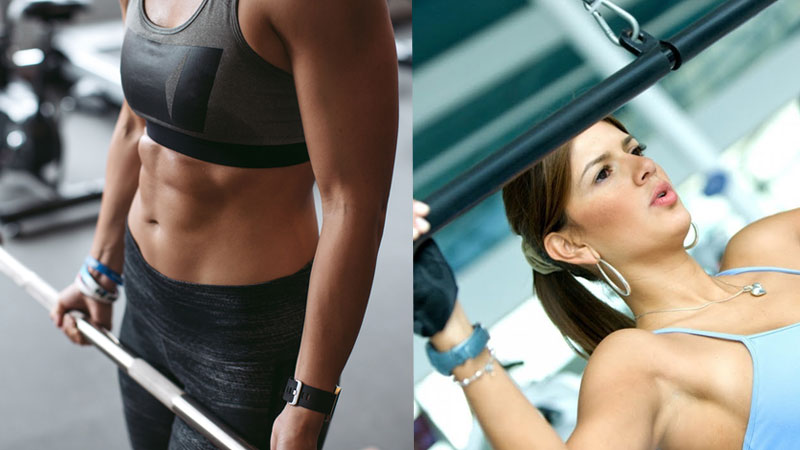
The Relationship Between Weight Training and Female Hormones
As a strong, athletic and confident woman you love to lift heavy things and get the job done. Weight training and female hormones is becoming a popular subject for women wanting to optimize both their health, and their physiques.
The shift over the last couple of years has been awesome.
More and more women are ditching the treadmill and using weight training to build athletic, strong and downright sexy figures. The days of legwarmers, aerobics and little pink weights is well and truly behind us.
At this stage of your lifting life, you might have two main questions when it comes to weight training… How much weight should females lift, and how strength training affects female hormone.
You already know that an exercise program with weight training can melt fat, build shape and help to keep you trim and toned. The next stage is finding out how it affects your cycle and your hormones.
In this article we answer that very question.
So find a space on the sofa, grab a protein shake and give yourself some time to read this enlightening guide on weight training and female hormones.
The Female Weight Training Revolution
For years and years, women shied away from the weights room.
Some avoided the iron because the gym was an intimidating environment fully of sweaty men grunting their way through a heavy workout. Others avoided strength training for fear of growing huge slabs of muscle and masculine bodies.
And those that did choose to use weights would often follow celeb trainers who advocated using only light weights.
That’s all changed.
Women are now ruling the iron game. You’re not afraid to mix it up with the guys and through education, scientific research and some fantastic female pioneers we’ve all learned that weight training provides a huge number of benefits:
The benefits of weight lifting for women
- Tones, shape and lift specific muscles
- Increase daily energy expenditure and fat burning
- Protects your muscle and bone mass
- Lifts your energy levels and mood as well as reducing stress, anxiety, and depression
- Improves posture and reduces injuries
- Teaches you new skills that improve functional and sports performance
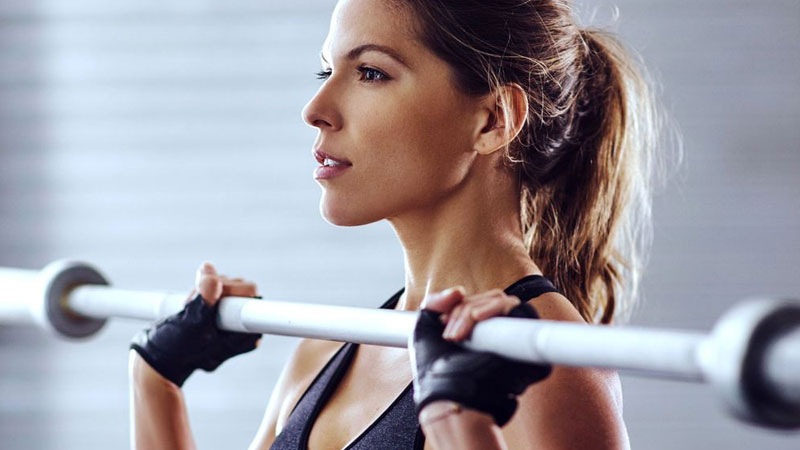
What Happens During Your Menstrual Cycle?
The benefits of strength training for women are all determined by changes to your body.
The mechanical load of weightlifting forces your body to adapt by growing new muscle cells, remodeling bone tissue, using stored fat as fuel and strengthening nervous system communication networks.
It really is the fountain of youth.
Several things control the way that your body adapts to exercise. And one of those is your hormonal system.
Men and women share a number of the same hormones. Insulin, thyroid, glucagon, cortisol etc.
But the one thing that differentiates you from the guys is your menstrual cycle.
There are three main hormones that are involved during your cycle:
- Estrogen – the primary female hormone that promotes health, regulates sex characteristics and triggers ovulation.
- Progesterone – responsible for thickening the lining of your uterus.
- Testosterone – a natural anabolic hormone found in small amounts in females.
When it comes to weight training and female hormones, these are the ones you need to know about.
Your menstrual cycle is split into three phases
Every woman is different, and menstrual cycles are a perfect example of why each female is special in her own right.
Most women have a cycle that lasts somewhere between 21-35 days. The average is 28 days. Some women have irregular periods, and some don’t have one at all (amenorrhea).
If you have a ‘normal’ cycle, this is what you can expect to see…
- Follicular phase – days 1-14: This is where your uterine lining is shed and menstrual bleeding occurs for the first 3-5 days.
- Ovulation – days 14-15: During this short phase, an egg is released from your ovaries.
- Luteal phase – 15-28: In this last phase, the egg implants itself ready for fertilization. If this doesn’t happen, your uterine lining begins to degrade and your body prepares to shed it
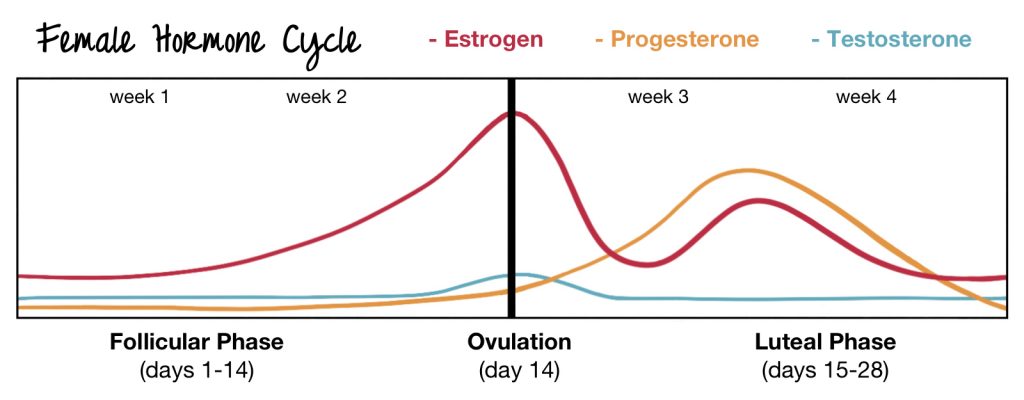
Hormonal fluctuations across the cycle
As you can imagine, the peaks, valleys, and changes to menstrual hormones are what controls your period. These have both a physiological and psychological influence, and should be taken into account when weight training.
Estrogen
As the primary female sex hormone, estrogen is responsible for promoting bone health, protecting your vascular system and even reducing the risk of some female cancers.
During the follicular phase, estrogen starts to increase. It peaks during ovulation, and then dies down again during the luteal phase. There’s a second, much smaller dip during the mid-luteal phase.
Testosterone
This natural steroidal hormone regulates lean mass, endurance, fitness, and stamina. It is also highly correlated with libido and sex drive too.
Levels of testosterone remain fairly constant over the course of your period, with a small peak around the time of ovulation.
Many evolutionary scientists think that this peak coincides with the best time for you to get pregnant (when you’re ovulating), so ramping up your libido makes sense from that point of view.
Progesterone
This hormone remains low throughout the whole of the follicular and ovulation phases, peaking midway through the luteal phase.
It falls again once the luteum lining begins to degrade.
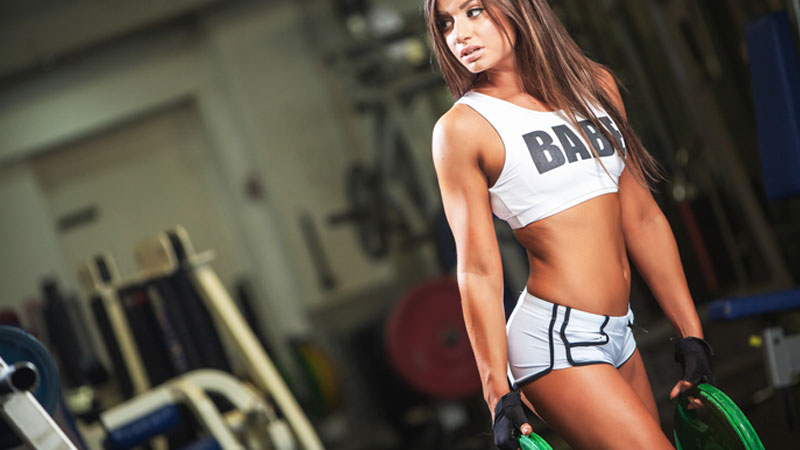
The Weight Training and Female Hormones Connection
Your menstrual cycle is a beautiful thing.
The concerto of different hormones working together to manage, regulate and maintain your cycle is a scientific and evolutionary phenomenon.
And with the right approach, the changes in hormone levels during your period can be used to your strength training advantage.
Here’s how weight training and female hormones work together to help you build a better body…
Estrogen helps you recover fast and reduces muscle damage
As the dominant female hormone, estrogen plays the role of protector.
It reduces fatigue and muscle damage, meaning you can tolerate higher levels of volume during weight training (and high-intensity cardio too), without negative effects.
Estrogen also helps to blunt pain.
During the follicular phase of your cycle, in particular, you’ll develop machine-like tolerance and stamina when weight lifting.
This means your time-to-exhaustion and general stamina in the weights room will be optimal during the follicular and ovulatory phases.
[infobox]Key Points on estrogen:
- Heavy weight training sessions with lots of volume are best during the follicular phase when estrogen is high.
- You’ll experience lower levels of muscle damage and fatigue when estrogen is elevated, so you’ll be able to train hard and recover much faster.
- Your exercise performance is optimal during mid-to-late follicular phase and through to ovulation when estrogen is at its highest.
Testosterone builds fitness and lean mass
As a regular reader of SpotMeGirl you’ll know how much we value the role of testosterone for athletic women who want to develop a sexier, leaner body with toned muscle and no huge mass.
Women who have optimal levels of testosterone also have:
- More energy and endurance
- Better strength and lean mass
- Lower levels of body fat
- More confidence
- Fewer mood swings during their period
Normal levels of testosterone for women is a low 25-70 ng.dL – that’s nearly 15 times lower than a man, and one of the reasons why women can’t build muscle mass like men can.
With 90% of women over 45 suffering from low testosterone levels, it’s a hormone that needs boosting. The biggest drop in natural anabolic hormone levels occurs between 20 and 40 years of age.
Discover our top T-boosters for women here:
Weight training has been shown in numerous research studies to elevate testosterone levels, especially during late follicular and ovulatory phases when the hormone is elevated already.
In fact, many women chasing PRs on big lifts such as the bench press or squat attempt a new record between days 10-15 of their cycle to try and use the natural spike in testosterone to their advantage.
When it comes to weight training and female hormones, testosterone is hugely important.
[infobox]Key Points on testosterone:
- Testosterone promotes increases in lean mass, while at the same time helping reduce excess body fat.
- The best time to go for a PR or hard strength workout is from the follicular phase through to ovulation. The combination of elevated estrogen and testosterone is key to optimal athletic performance.
Progesterone elevates body temperature
Your body temperature is higher during the phase when progesterone is elevated, meaning tough weight training workouts can leave you feeling hot, tired and uncomfortable.
It’s common for women to reduce the intensity of their weight training workouts during the luteal phase when body temperature is around 1 degree Celsius higher than normal.
Progesterone has a catabolic effect that increases muscle damage and can lead to an increase in fatigue and reduction in athletic performance.
On the plus side though, your body burns more fat during the luteal phase, so a bit more cardio and circuit training, with less heavy weight lifting works well here.
[infobox]Key Points on progesterone:
- Progesterone can elevate muscle damage and make recovery from weight training hard, especially at high intensity.
- Due to catabolic effects of progesterone, heavy weight training during the luteal phase can be tough.
Summary – How Weight Training and Female Hormones Are Related
Natural female hormones such as estrogen, testosterone and progesterone go hand in hand with strength training.
Adapting the way you train based on menstrual cycle hormone fluctuations can take your muscle-toning, fat-burning results to the next level.
If you enjoyed this article you can learn more here…
- What are the benefits of exercise during your period?
- How your cycle affects your lifting
- Fast weight loss – cardio machines that burn the most calories


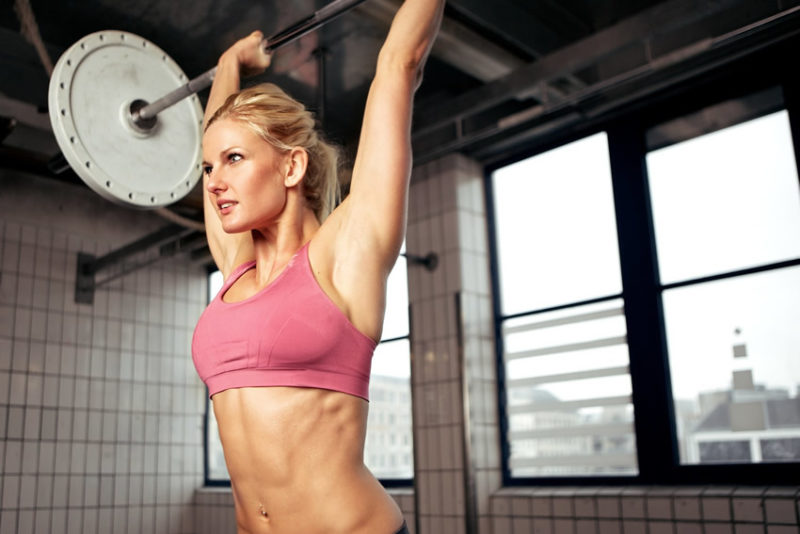
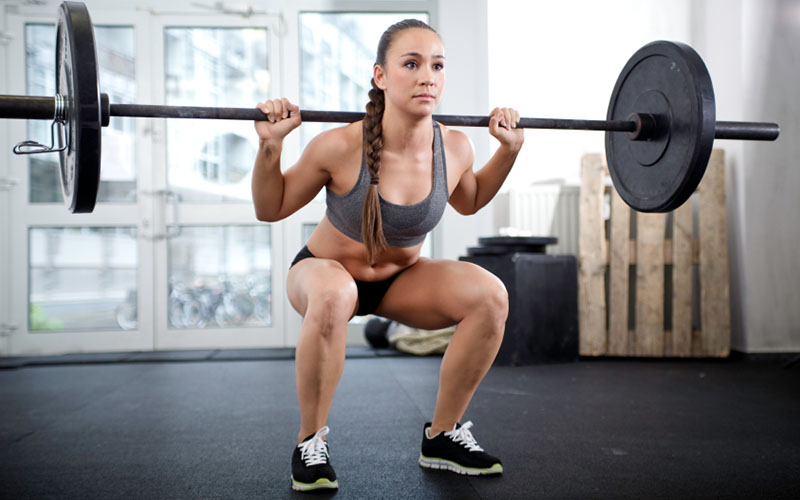
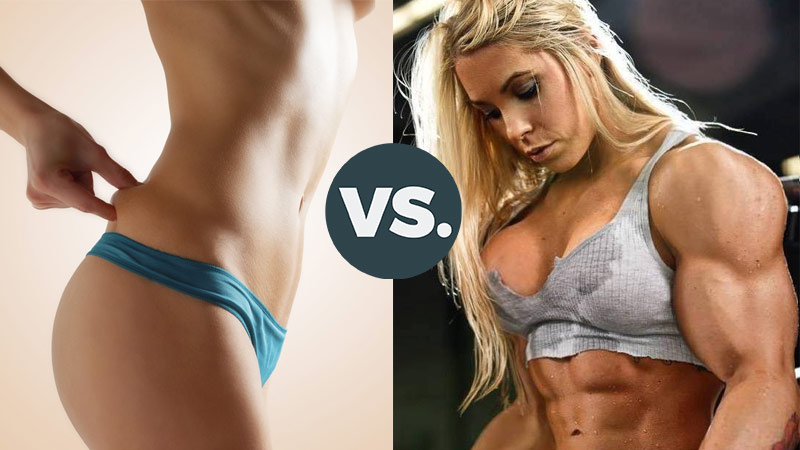
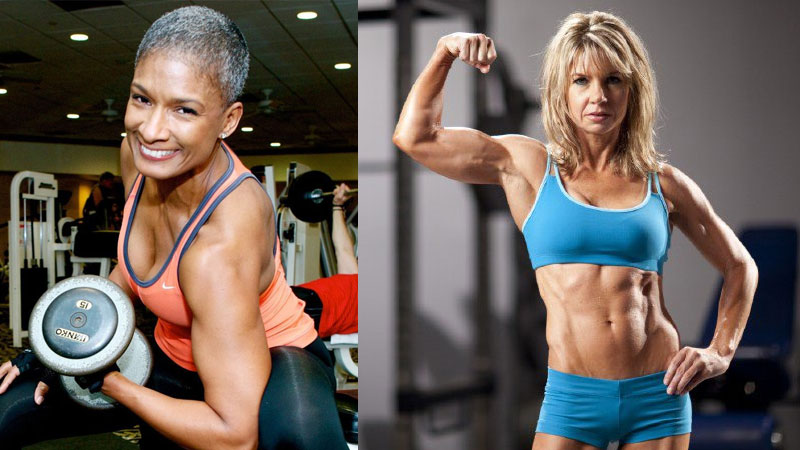
Good information for really needed this
This is a really useful and fascinating article- I’d also love to hear about how the Peri-menopausal and post-menopausal hormone changes affect how and where women should focus their exercise training.
Jules